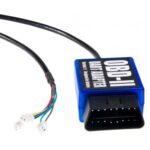Dealing with engine troubles in a 1996 Celica GT, especially when facing emissions regulations, can present unique challenges. The owner of a ’96 Celica GT with a 5S-FE engine, suffering from a spun bearing, is exploring engine swap options while needing to maintain OBD2 compliance for eCheck requirements. Let’s delve into the possibilities of a 3sgte Obd2 swap and other viable alternatives for this situation.
One straightforward path considered is sticking with the S-family engines. The 5SGE or Gen2-3 3SGE swaps are presented as near plug-and-play solutions. These options offer a performance upgrade while potentially simplifying the OBD2 integration. Utilizing a GE head and considering overboring the block for higher compression pistons could further enhance the performance of a 5SGE or 3SGE setup. While sensor porting might be necessary, this option is viewed as relatively manageable.
However, the allure of the turbocharged 3SGTE engine is strong. The article explores the feasibility of a Gen2 3SGTE swap while crucially maintaining OBD2 functionality. To achieve this, several key modifications are proposed, drawing parallels to a 3SGE swap in terms of complexity. The core strategy revolves around adapting the 3SGTE to be compatible with the existing OBD2 system of the 5S-FE.
The proposed method for a 3SGTE OBD2 swap involves several critical steps. Firstly, swapping the 5S crank gear and crank sensor onto the 3SGTE is essential, as the Gen2 3SGTE typically relies on the distributor for both cam and crank position sensing. Secondly, utilizing the 5S distributor is suggested to maintain the correct sensor inputs for the OBD2 system. Crucially, the plan emphasizes swapping over every sensor from the original 5S-FE engine to the 3SGTE. This comprehensive sensor swap aims to ensure that the ECU receives familiar signals, aiding in OBD2 compliance. Creative vacuum line configurations are also mentioned as a way to adapt the factory 5S MAP sensor to the turbocharged 3SGTE. Finally, retarding the base timing is noted as a necessary adjustment, considering the 5S-FE’s tendency to add significant timing at wide-open throttle.
While the prospect of a 3SGTE OBD2 swap into a 1996 Celica GT might seem daunting, the outlined approach provides a framework for achieving this goal. The emphasis on sensor compatibility and careful adaptation suggests a pathway to retain OBD2 functionality. This detailed exploration moves beyond simple dismissal and encourages an informed discussion, offering valuable insights for anyone considering a similar engine swap while needing to navigate OBD2 requirements. Further research and careful execution would be necessary to validate this approach and ensure a successful 3SGTE OBD2 conversion for the Celica GT.

